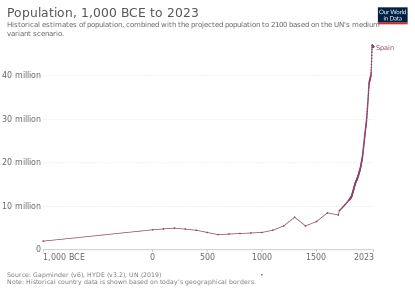
Back سكان إسبانيا Arabic Население на Испания Bulgarian Demografia d'Espanya Catalan Obyvatelstvo Španělska Czech Demograffeg Sbaen Welsh Demografie Spaniens German Demografía de España Spanish Démographie de l'Espagne French Demografía de España Galician Իսպանիայի բնակչություն Armenian
| Demographics of Spain | |
|---|---|
 Population pyramid of Spain in 2021 | |
| Population | 48,692,804[1] (2024 est.) |
| Growth rate | 0.13% (2022 est.) |
| Birth rate | 6.9 births/1,000 population (2022) |
| Death rate | 9.8 deaths/1,000 population (2022) |
| Life expectancy | 82.55 years |
| • male | 79.84 years |
| • female | 85.4 years |
| Fertility rate | |
| Infant mortality rate | 2.47 deaths/1,000 live births |
| Net migration rate | 4.35 migrant(s)/1,000 population |
| Age structure | |
| 0–14 years | 14.26% |
| 15–64 years | 65.97% |
| 65 and over | 19.77% |
| Sex ratio | |
| Total | 0.95 male(s)/female (2022 est.) |
| At birth | 1.05 male(s)/female |
| Nationality | |
| Nationality | Spaniards |

| Year | Pop. | ±% p.a. |
|---|---|---|
| 0 | 4,600,000 | — |
| 500 | 4,000,000 | −0.03% |
| 1000 | 4,000,000 | +0.00% |
| 1300 | 7,500,000 | +0.21% |
| 1500 | 6,500,000 | −0.07% |
| 1600 | 8,500,000 | +0.27% |
| 1700 | 8,000,000 | −0.06% |
| 1833 | 12,286,941 | +0.32% |
| 1846 | 12,162,872 | −0.08% |
| 1857 | 15,464,340 | +2.21% |
| 1877 | 16,622,175 | +0.36% |
| 1887 | 17,549,608 | +0.54% |
| 1900 | 18,616,630 | +0.46% |
| 1910 | 19,990,669 | +0.71% |
| 1920 | 21,388,551 | +0.68% |
| 1930 | 23,677,095 | +1.02% |
| 1940 | 26,014,278 | +0.95% |
| 1950 | 28,117,873 | +0.78% |
| 1960 | 30,582,936 | +0.84% |
| 1970 | 33,956,047 | +1.05% |
| 1981 | 37,683,363 | +0.95% |
| 1991 | 38,872,268 | +0.31% |
| 2001 | 40,847,371 | +0.50% |
| 2011 | 46,815,916 | +1.37% |
| 2021 | 47,400,798 | +0.12% |
| 2024 | 48,692,804 | +0.90% |
| Source: INE and Our World in Data | ||
As of 1 April 2024, Spain had a total population of 48,692,804.[2] The modern Kingdom of Spain arose from the accretion of several independent Iberian realms, including the Kingdoms of León, Castile, Navarre, the Crown of Aragon and Granada, all of which, together with the modern state of Portugal, were successor states to the late antique Christian Visigothic Kingdom after the Reconquista.
Spain's population surpassed 48 million inhabitants for the first time in history. In 2024 the population peaked, there are 48,692,804[3] people living in Spain. Its population density, at 97.0 inhabitants per square kilometre (251/sq mi), is lower than other Western European countries, yet, with the exception of microstates, it has the highest real density population in Europe, based on density of inhabited areas.[4] With the exception of the capital Madrid, the most densely populated areas lie around the coast.
The population of Spain doubled during the twentieth century, but the pattern of growth was extremely uneven due to large-scale internal migration from the rural interior to the industrial cities. Eleven of Spain's fifty provinces saw an absolute decline in population over the century.
The last quarter of the century saw a dramatic fall in birth rates. Spain's fertility rate of 1.47 (the number of children the average woman will have during her lifetime) has climbed every year since the late 1990s. The birth rate has climbed in 10 years from 9.10 births per 1000 people per year in 1996 to 10.9 in 2006, before declining again to 7.13 by 2021.
In 2021 the Total Fertility Rate of Spain (average number of children per woman) was 1.19, and 3.7% was the percent of births to women that were their 4th+ child.
Spain accepted 478,990 new immigrant residents in the first six months of 2022 alone. During these first six months, 220,443 people also emigrated from Spain, leaving a record-breaking net migration figure of 258,547.[5] The data shows that more women than men chose to move to Spain during 2022, this is due to higher rates of emigration from Latin America.[5]
- ^ "INEbase / Estadística Continua de Población (ECP). Datos provisionales". ine.es. Retrieved 1 April 2024.
- ^ "INEbase / Estadística Continua de Población (ECP). Datos provisionales". ine.es. Retrieved 1 April 2024.
- ^ "INEbase / Estadística Continua de Población (ECP). Datos provisionales". ine.es. Retrieved 1 April 2024.
- ^ "These maps reveal the truth about population density across Europe". 25 January 2018.
- ^ a b Betty Henderson (26 January 2023). "Immigration resumes to pre-pandemic levels in Spain with more women immigrants than men". EuroWeekly News.
© MMXXIII Rich X Search. We shall prevail. All rights reserved. Rich X Search